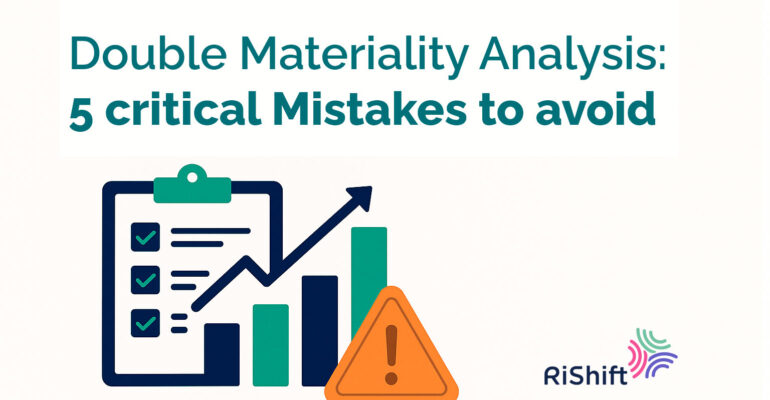Double Materiality Analysis: 5 Critical Mistakes to Avoid
More and more companies are hearing about double materiality. While the term sounds technical, even intimidating, it often gets reduced to a colorful matrix buried in sustainability reports—unread by executives, let alone the board—and forgotten in a folder.
But when done right, double materiality isn’t a checkbox exercise. It’s a compass that reshapes how a company understands its present and plans its future.
At RiShift, we’ve learned this isn’t about compliance. It’s about leveraging a tool to make better business decisions.
Companies that take double materiality seriously don’t chase “trendy” topics for their annual reports. They identify the issues that belong at the heart of their strategy. Because a robust double materiality analysis isn’t just a list of topics—it’s a framework to:
- Map the business ecosystem,
- Drive financial planning,
- Strengthen risk management, and
- Ensure regulatory compliance.
We’ve seen the difference. Companies that prioritized quality over checklists achieved tangible results:
- Uncovering hidden risks and designing mitigation plans before crises hit,
- Spotting untapped opportunities and turning them into competitive advantages,
- Making evidence-based financial decisions (no more guesswork),
- Prioritizing investments with sustainable returns, and
- Creating a living document that evolves with the business and its environment.
If you want double materiality to be truly strategic, avoid these 5 critical mistakes.
Mistake #1: Failing to align your materiality analysis with the new rules of the game
Regulatory frameworks are no longer optional. They’re defining global reporting and management standards.
Your double materiality analysis must be designed around interoperable international frameworks from the start:
- IFRS S1 & S2 (ISSB standards for financial and climate risk disclosures)
- GRI (to report societal and environmental impacts),
- EFRAG IG 1 (the gold-standard methodology for double materiality under EU CSRD, aligned with GRI and IFRS).
Alignment ensures your analysis is audit-ready, not just a decorative matrix.
Mistake #2: Defining material topics without linking them to sustainability risks and opportunities (SRROs)
Many analyses stop at identifying “relevant topics” (climate change, human rights, supply chain…). Identification isn’t enough.
The real value lies in framing each topic through its Sustainability-Related Risks and Opportunities (SRROs). Ask:
- How does climate change affect our business?
- What decisions does it demand?
- Where are the opportunities?
This is non-negotiable for IFRS S1/S2 reporting, where vague claims won’t cut it. Poorly framed topics hide risks—and unseen risks can’t be managed.
Mistake #3: Superficial stakeholder engagement
Everyone claims to “engage stakeholders.” Few do it well.
Real engagement isn’t mass surveys or cherry-picked quotes for reports. It’s about:
- Asking the right questions to the right people,
- Using frameworks like AA1000 and IAP2 to ensure relevance, traceability, and inclusivity, and
- Turning insights into actionable decisions.
If you can’t explain how and why you engaged stakeholders, you likely did it wrong.
Mistake #4: Assessing financial risks with “gut feeling” instead of data
Vague surveys or finger-in-the-wind estimates create false confidence. Clarity comes from data.
A rigorous double materiality analysis requires:
- Industry benchmarks (public data, case studies),
- Tailored financial scenarios, and
- Quantifiable impact models with key financial metrics.
This transforms your analysis from a PowerPoint slide to a strategic management tool.
Mistake #5: Treating sustainability and corporate risk management as separate silos
Double materiality isn’t just the sustainability team’s job. Done right, it’s cross-functional, speaking the language of:
- Strategy,
- Risk, and
- Business performance.
Integrate frameworks like COSO-ERM or ISO 31000, and collaborate with risk teams to unify risk agendas. Sustainability should strengthen—not compete with—traditional risk management.
Double Materiality: A Leadership Tool
At RiShift, we design materiality analyses that become strategic assets, not decorative reports. Our clients navigate and IFRS S transitions with clarity, confidence, and competitive edge.
Ready to transform your approach? We’re ready to guide you.
About RiShift: Your Strategic Sustainability Partner
RiShift is a consultancy specializing in sustainability strategy, culture, and compliance. Since 2019, we’ve helped 20+ multinationals turn sustainability into real competitive advantages.
Why choose RiShift for double materiality?
- IFRS S1/S2, GRI, and EFRAG IG 1-aligned analyses,
- Financially quantified risk models,
- Full integration with corporate risk frameworks (COSO, ISO 31000),
- AA1000/IAP2 stakeholder engagement.
Our services:
✅ Double materiality analysis
✅ Climate risk modeling & quantification
✅ IFRS S reporting implementation
✅ Risk management system integration
✅ Training (board to supply chain).
Book a free 30-minute consultation to assess your IFRS S readiness and build a tailored roadmap.
📞 Contact us:
Email: hello@rishift.com
Phone: +52 (81) 2213-8731



